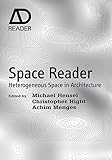Space reader : heterogeneous space in architecture / edited by Michael Hensel, Christopher Hight, Achim Menges.
Material type: TextLanguage: English Series: AD readerChichester, U.K. : Wiley, 2009©2009 Description: 224 pages : illustrations, plans ; 26 cmContent type: text Media type: unmediated Carrier type: volumeISBN: 0470519428 (hardback)Other title: Heterogeneous space in architectureSubject(s): Space (Architecture) | City planning -- Philosophy | Architecture and societyLOC classification: NA2765 .S73 2009Review: The Space Reader provides a highly pertinent and contemporary understanding of space for a new generation of students and architects. It espouses a definition of space that is heterogeneous (an object or system consisting of a diverse range of different items). An example of heterogeneous space, for instance, is Manhattan where complex and multiple social and technological conditions are overlaid. (This is to be contrasted with highly centralised and ordered Modernist cities.) With the onset of globalisation and the Web, heterogeneneous space, with its emphasis on differentiation, is more relevant to the contemporary condition, which encourages the mixing of space, than a much more static conception of Modernist space. This book foregrounds spatial issues and the potential of heterogeneous space through a threefold strategy: 1) Its compilation of seminal essays on the discourse of heterogeneous space. These are to include previously published key texts by Reyner Banham, Andrew Benjamin, Robin Evans, Jeff Kipnis and Henri Lefebvre, as well as new texts by important contemporary commentators, such as Mark Cousins, Werner Durth and Anthony Vidler. 2) By commenting on these seminal texts and drawing links between them. 3) By distilling from the first two efforts a contemporary outlook on a discourse of heterogeneous space that is of future significance.--Back cover.
TextLanguage: English Series: AD readerChichester, U.K. : Wiley, 2009©2009 Description: 224 pages : illustrations, plans ; 26 cmContent type: text Media type: unmediated Carrier type: volumeISBN: 0470519428 (hardback)Other title: Heterogeneous space in architectureSubject(s): Space (Architecture) | City planning -- Philosophy | Architecture and societyLOC classification: NA2765 .S73 2009Review: The Space Reader provides a highly pertinent and contemporary understanding of space for a new generation of students and architects. It espouses a definition of space that is heterogeneous (an object or system consisting of a diverse range of different items). An example of heterogeneous space, for instance, is Manhattan where complex and multiple social and technological conditions are overlaid. (This is to be contrasted with highly centralised and ordered Modernist cities.) With the onset of globalisation and the Web, heterogeneneous space, with its emphasis on differentiation, is more relevant to the contemporary condition, which encourages the mixing of space, than a much more static conception of Modernist space. This book foregrounds spatial issues and the potential of heterogeneous space through a threefold strategy: 1) Its compilation of seminal essays on the discourse of heterogeneous space. These are to include previously published key texts by Reyner Banham, Andrew Benjamin, Robin Evans, Jeff Kipnis and Henri Lefebvre, as well as new texts by important contemporary commentators, such as Mark Cousins, Werner Durth and Anthony Vidler. 2) By commenting on these seminal texts and drawing links between them. 3) By distilling from the first two efforts a contemporary outlook on a discourse of heterogeneous space that is of future significance.--Back cover.
| Item type | Current library | Shelving location | Call number | Copy number | Status | Date due | Barcode |
|---|---|---|---|---|---|---|---|
| Books | MEF Üniversitesi Kütüphanesi | Genel Koleksiyon | NA 2765 .S73 2009 (Browse shelf (Opens below)) | Available | 0011587 | ||
| Books | MEF Üniversitesi Kütüphanesi | Genel Koleksiyon | NA 2765 .S73 2009 (Browse shelf (Opens below)) | c.2 | Available | 0011774 |
Browsing MEF Üniversitesi Kütüphanesi shelves, Shelving location: Genel Koleksiyon Close shelf browser (Hides shelf browser)

|

|

|

|

|

|

|
||
| NA 2765 .P471 2013 Perception of space in architecture and culture : study of industrial ruins : international summer school / | NA 2765 .P472 2014 Perception of space in architecture and culture : sensory living : international summer school / | NA 2765 .S615 2020 Spatial practices : modes of action and engagement with the city / | NA 2765 .S73 2009 Space reader : heterogeneous space in architecture / | NA 2765 .S73 2009 Space reader : heterogeneous space in architecture / | NA 2765 .V45 2016 Bir açılış olarak mekan = Enclosure as a disclosure / | NA 2765 .V57 2020 Visual spatial enquiry / |
Includes bibliographical references (pages 218-219) and index.
The Space Reader provides a highly pertinent and contemporary understanding of space for a new generation of students and architects. It espouses a definition of space that is heterogeneous (an object or system consisting of a diverse range of different items). An example of heterogeneous space, for instance, is Manhattan where complex and multiple social and technological conditions are overlaid. (This is to be contrasted with highly centralised and ordered Modernist cities.) With the onset of globalisation and the Web, heterogeneneous space, with its emphasis on differentiation, is more relevant to the contemporary condition, which encourages the mixing of space, than a much more static conception of Modernist space. This book foregrounds spatial issues and the potential of heterogeneous space through a threefold strategy: 1) Its compilation of seminal essays on the discourse of heterogeneous space. These are to include previously published key texts by Reyner Banham, Andrew Benjamin, Robin Evans, Jeff Kipnis and Henri Lefebvre, as well as new texts by important contemporary commentators, such as Mark Cousins, Werner Durth and Anthony Vidler. 2) By commenting on these seminal texts and drawing links between them. 3) By distilling from the first two efforts a contemporary outlook on a discourse of heterogeneous space that is of future significance.--Back cover.
